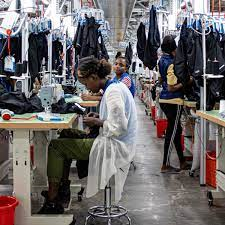By Jemimah Chungu
As the global thirst for latest fashion increases, so does fast fashion. Fast fashion is a term used to describe a highly profitable and exploitative business model based on replicating or imitating catwalk trends and high-fashion designs, and mass-producing them at low cost. The term fast fashion is also used to generically describe the products of the fast fashion business model.
The fast fashion business model first emerged during the late 20th century as manufacturing of clothes became cheaper and easier, through new materials including polyester and nylon. It was later popularized by efficient supply chains and quick response manufacturing methods, and inexpensive labor in sweatshop production and low-labor protection bulk clothing manufacturing industries in South, South East, and East Asia. There are fashion production companies that built business models based on inexpensive clothing from the efficient production lines, to create more seasonal and trendy designs that are aggressively marketed to fashion-conscious consumers (Wikipedia).
Fast fashion smears non-dashing forms of planned unfashionableness to fashion and humanity. Fast fashion designs lack originality, for example an imitation of an African print like Kanga, Ankara or Chitenge produced in china. Stealing designs is also common in fast fashion. Prominent fashion designers like Gucci, Dior, Burberry, Balenciaga, channel and many others put in a lot of handy work and design their fashion products yet fast fashion producers imitate their work with insult of making them IN low quality and selling them at cheap price.
Fast fashion is also associated negative impact on the environment bearing in mind that people are the first class benefits of the environment. There is a lot of pollution of water, land (soil degradation), air and the rest of the environment during production using chemical effluents disturbing ecosystems, wildlife, fauna and flora both on land and water. This generally degrades environmental good and services like food and life itself that humans need for survival and the balance of nature. For example, pesticide used in industrial cotton growth, fossil fuel extraction for synthetic materials or slave labor in sweatshops affects the environment.
Greenhouse gasses alone are produced at a large scale in fast fashion. The global fashion industry is generating a lot of greenhouse gases due to the energy used during its production, manufacturing, and transportation of the millions garments purchased each year.
Synthetic fibers (polyester, acrylic, nylon, and others), used in the majority of our clothes, are made from fossil fuel, making production much more energy-intensive than with natural fibers. Most of our clothes are produced in China, Bangladesh, or India, countries essentially powered by coal. This is the dirtiest type of energy in terms of carbon emissions (sustainyourstyle.org).
It is no secret that these materials and chemicals are the most impactful to nature and people.
Fast fashion also use a lot of Water during production at the expense of important aquatic life such as fish, crabs, sharks, sardines to list a few. High water consumption also affects people’s daily uses for water and latent uses such as ecosystem benefits.
A lot of waste is produced from fast fashion because a lot of clothes are produced and purchased with less approach to waste management and sustainable fashion. More so, much clothing produced under the fast fashion model is lower quality. Therefore waste management precisely reusing or recycling is a challenge. An increase in waste bears a lot of environmental impacts including visual pollution, environmental pollution and ultimately climate change alongside its impacts.
Deforestation rates also increase with fast fashion as the need for wood-based fabrics such as rayon, viscose, and modal cause fast fashion firms to clear reserves and replace them with the trees.
Trees are very useful for the environment for wildlife habitats, carbon sinks, the climate change culprit, food, and natural cycles like rain, carbon and nitrogen cycle and to state the list, ecosystems.


